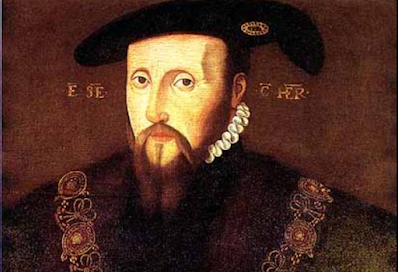The Tudors as a dynasty executed many people, both high and low. But the nobility were the ones consistently involved in treason, either deliberately or unconsciously. Exploring the long sixteenth century under each of the Tudor monarchs gives a sense of how and why so many were executed for what was considered the worst possible crime and how the definition of treason changed over the period. This book examines how and why Tudor nobles like Edward Stafford, 3rd Duke of Buckingham; Queen Consort Anne Boleyn; Henry Howard, Earl of Surrey; and Robert Devereux, 2nd Earl of Essex, fell into the trap of treason and ended up on the block under the executioner’s axe. Treason and the Tudor nobility seem to go hand in hand as, by the end of the sixteenth century and the advent of the Stuart dynasty, no dukes remained in England. How did this happen and why?
Hi Tony, thanks for having me! I’m going to talk about some of the perhaps unknown or unexplored connections between different Tudor nobles who were executed, from my new book ‘
Tudor Executions: From Nobility to the Block’.
The idea for the book came from the fact I discovered when doing some reading that there were no dukes left in England by the end of Tudor period. Elizabeth I executed Thomas Howard, 4th Duke of Norfolk, in 1572, and there wasn’t another duke created until James I created George Villiers the duke of Buckingham in 1623. That’s a 51-year period with no dukes in England and I wondered why and how that happened.
Thomas Howard, 4th Duke of Norfolk
I started to write about the first execution in the book, which is that of Edward Plantagenet, 17th Earl of Warwick, who was executed on 28 November 1499 on the orders of Henry VII. I then realised that his is part of the story of a royal Yorkist brother and sister executed by a royal Tudor father and son. Warwick’s sister was Margaret Pole, Countess of Salisbury, who was executed by Henry VIII on 27 May 1541.
The Earl of Warwick and Margaret Pole were the children of George Plantagenet, 1st Duke of Clarence, and Isabel Neville, and thus were niece and nephew of Edward IV and Richard III. The Tudors were still relatively new on the throne in 1509 when Henry VIII succeeded his father. Henry VIII understood that he needed a son to succeed him to protect the Tudor line, otherwise there was a real threat that the Wars of the Roses could resume. Warwick and Margaret Pole were victims of the Tudors wiping out anyone else with a claim to the throne, and they were seen as part of the Yorkist White Rose group.
These weren’t the only siblings to be executed by the Tudors – others include Anne and George Boleyn, and Edward and Thomas Seymour. The Seymour brothers were executed by a Tudor king who was also their nephew, Edward VI. Jane Seymour was the third wife of Henry VIII, who married the king just eleven days after the execution of his second wife, Anne Boleyn, in May 1536. She gave birth to the son and heir Henry was desperate for in October 1537 but died days later. She was the only of Henry VIII’s six wives to have a royal burial.
When Edward Seymour was created Duke of Somerset and Lord Protector when Edward VI came to the throne, Thomas Seymour was made Lord Admiral and Baron Seymour of Sudeley. Thomas Seymour became jealous and tried to kidnap the king, executed in 1549 on the authority of his nephew and brother. Edward Seymour, Duke of Somerset, was weakened by his brother’s execution, and was stripped of the office of Lord Protector and sent to the Tower, but then was released and restored to the Privy Council, before he was accused of plotting against the Duke of Northumberland. This time, he did not survive and was executed in 1552.
Edward Seymour, Duke of Somerset
The Howard family seem to have been particularly prone to execution and accusations of treason in the Tudor period. The first executions were in May 1536 when Anne and George Boleyn, niece and nephew to Thomas Howard, 3rd Duke of Norfolk, were executed on charges of adultery, incest, and treason.
We know Anne Boleyn best as the second wife of Henry VIII. Further executions followed in February 1542 when Katherine Howard, another niece of the 3rd Duke of Norfolk and cousin to Anne Boleyn, as well as fifth wife of Henry VIII, was executed for adultery. Jane Boleyn, widow of George Boleyn, was also executed at this time. So far, that’s two nieces, a nephew, and a niece-by-marriage of the 3rd Duke of Norfolk executed within six years.
The 3rd Duke of Norfolk himself narrowly avoided execution in January 1547, saved only by the death of Henry VIII. However, his son wasn’t so lucky and Henry Howard, Earl of Surrey, was executed in January 1547 days before the king’s death. The final Howard execution was in 1572 when Henry Howard, Earl of Surrey’s, son, Thomas Howard, 4th Duke of Norfolk, was executed for involvement in a plot to rescue Mary Queen of Scots, known as the Ridolfi Plot. Within 36 years, Thomas Howard, 3rd Duke of Norfolk, one of the great survivors of the Tudor age, lost two nieces who were both Queens of England, a nephew, a niece-by-marriage, a son, and a grandson to the executioner.
Many of the nobility were interconnected through marriage in the Tudor period, but there were many siblings, and whole family groups who were wiped out by the Tudor monarchs, ending some of the most influential titles of the period, including the dukedoms of Buckingham (1521), Somerset (1552), Northumberland (1553), Suffolk (1554), and Norfolk (1572). These families all had royal ties in one way or another and it was this link, and their focus on the succession, that ultimately resulted in their downfalls. The Tudors did not feel safe on their throne, and there were several families with claims on the throne, quite probably better claims than the Tudors in several cases. This fear resulted in them wiping out the most prominent people and families in England.
Helene Harrison
# # #
About the Author
Helene Harrison studied at the University of Northumbria in Newcastle, achieving both a BA and an MA in History before going on to complete an MSc in Library Management. Her passion for Tudor history started when studying for A Levels and completing a module on Tudor rebellions. Her Masters dissertation focused on portrayals of Anne Boleyn through the centuries, from contemporary letters to modern TV and film adaptations. Now she writes two blogs, one Tudor history and one book-related, and loves visiting royal palaces and snuggling up with a book or embroidery project. Find out more at her website
https://tudorblogger.com/ and find Helene on
Facebook and Twitter
@tudorblogger

















.webp)




















